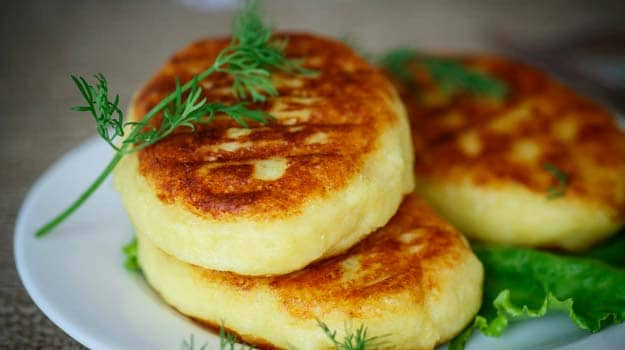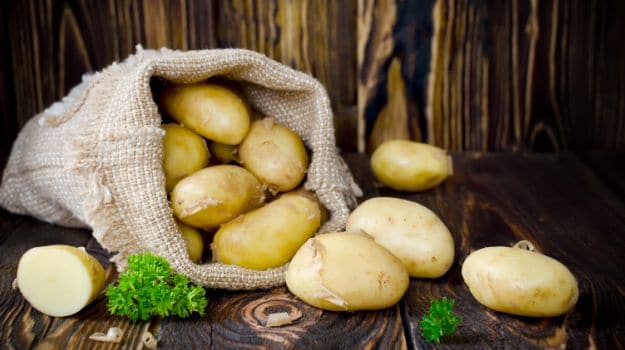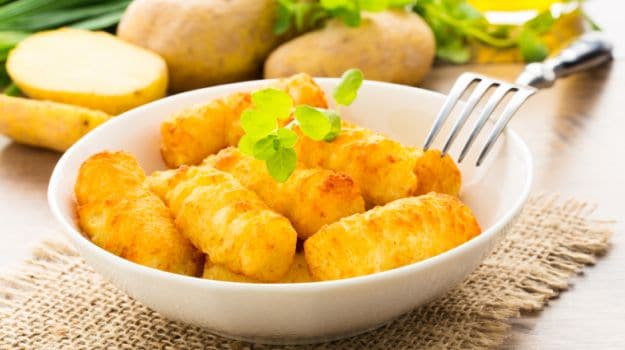 Potatoes are perhaps the most widely used vegetable across the globe. From fries to tikkis, potato dumplings to potato and leek soup, they astound with their versatility. They are also the quintessential fasting food. Many Navratri dishes celebrate these as the core ingredient like Aloo Ki Tikki and Aloo Ki Kadhi or in combination with other ingredients such as Kutti Ki Puri and Singhare Ki Matthi.
Potatoes are perhaps the most widely used vegetable across the globe. From fries to tikkis, potato dumplings to potato and leek soup, they astound with their versatility. They are also the quintessential fasting food. Many Navratri dishes celebrate these as the core ingredient like Aloo Ki Tikki and Aloo Ki Kadhi or in combination with other ingredients such as Kutti Ki Puri and Singhare Ki Matthi.
It is thus tragic that these poor dears are associated with obesity and weight gain. Every time we think of going on a weight reduction regimen, we cut out potatoes from our food. The truth is far removed from this, potatoes are as healthy as any other natural food. The way they are cooked and used is what decides their nutrition quotient. Deep fried chips, an all-time favourite, potato wafers or fried potato tikkis are not the best choices for healthy eating. However, if the chips are made in an air fryer, or you are using steamed potatoes, they can add nourishment to your day’s food.
Here’s why you should view potatoes in a better light (you’re going to love us!):
1. Calories: At 90 Kcal per 100, potatoes are low-calorie dense as compared to most cereals (energy count ranges from 300-400 Kcal/ 100g). While one chapatti made from whole wheat flour will provide 80 Kcal, one medium potato (about 70g) provides only 63 Kcal.
2. Potassium: 2 medium potatoes can meet 10% of the day’s requirement of potassium for an adult woman.
3. Fiber: Yes! Each medium potato gives you a gram of dietary fiber.
4. Vitamin B6: Also known as Pyridoxine, vitamin B6 is a water-soluble vitamin that plays an important role in the metabolism of proteins and synthesis of neurotransmitters. One medium potato gives as much as 42% of the day’s requirement for adults.
5. Antioxidants: In the lab, potatoes have been shown to exhibit free-radical scavenging activity. They may contribute important antioxidants such as carotenoids to our diet.
6. Blood Pressure Control: Potato extracts have been seen to inhibit ACE enzyme activity. This is one mechanism of controlling blood pressure which is used by a class of hypertension medication.
7. Potato Skins: Potato Skins are rich in minerals, vitamins and fiber
8. Workout Food: Potatoes provide carbs in the form of starch that is readily digested. They are a great energiser pre- and post-workout.

Health Tips to Keep in Mind While Eating Potatoes
A number of beneficial effects of potatoes have been observed in extracts made from raw potatoes. Thus, to preserve the nutritional quality, it’s better to avoid high temperature prolonged cooking (such as baking) while preparing potatoes.
Though low-calorie dense, they are not calorie free. Watch the portion size and use well in your meal. Ideally potatoes should replace a cereal preparation such as rice or chapatti in the diet, not add on as a sabzi like we do in India. If you’re having potato as the only cereal, you can have 2-2.5 medium potatoes in a meal. If there is another cereal in the meal, take only less than one medium potato (approx 70 g).

Potato Preparation Tips for Navratri
- Avoid frying as much as possible. The extra oil/ghee is what makes your potato dishes calorie-dense and sinful.
- Toss them in a teaspoon of oil and cook slowly in a wok. Follow up with seasonings of your choice.
- For a balanced meal, enjoy them with a glass of milk or a bowl of curd. The proteins will also keep you full and energised for longer.
- Stick to 1-2 potatoes per serving.
- Avoid having them every day and for every meal.
- Use with the skins on, to preserve nutrients.
- Prefer air-frying to shallow/deep-frying.
5 Tips on Using and Storing Potatoes
1. Boiling potatoes with their skins reduces the loss of water soluble nutrients.
2. Don’t only wash potatoes, but also scrub them before using. Being tubers, they gather a lot of dust.
3. Don’t store potatoes in the refrigerator or in the open. These stay best in a cool, dark, well ventilated place. Keep them in a basket in a cupboard or drawer, rather than in a polybag.
4. Cut off any green parts. Generally these do not have any effects, but may be toxic if ingested in extremely large amounts.
5. Potatoes that have started sprouting at the eyes are fit for consumption. Just cut off the sprouts.










